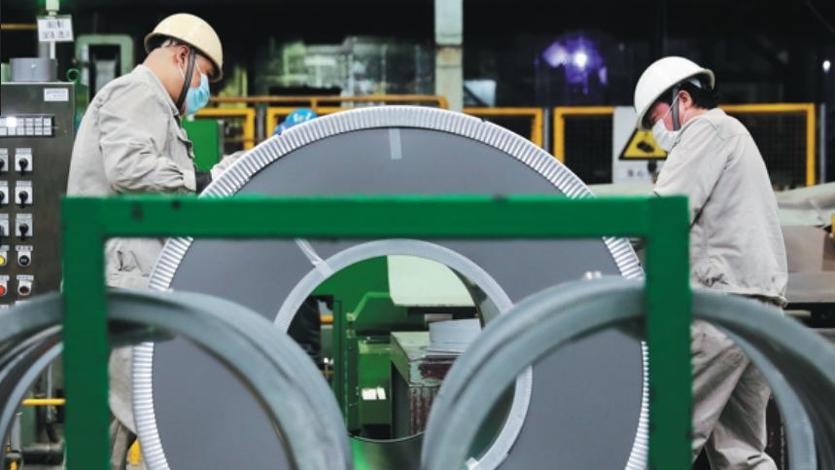 In this undated file photo, employees work on the production line of Baoshan Iron and Steel Co Ltd in Shanghai. (PHOTO / XINHUA)
In this undated file photo, employees work on the production line of Baoshan Iron and Steel Co Ltd in Shanghai. (PHOTO / XINHUA)
China on Wednesday announced plans to release the second batch of copper, aluminum and zinc from the national reserves to stabilize commodity prices, according to the country's top economic regulator and the state reserves authority.
The National Development and Reform Commission and the National Food and Strategic Reserves Administration said China will release 30,000 tons of copper, 90,000 tons of aluminum and 50,000 tons of zinc from its reserves toward this month-end.
On July 5, the NDRC and the NFSRA completed the release of the first batch, publicly auctioning 100,000 tons of copper, aluminum, and zinc.
More than 200 nonferrous metal processing and manufacturing companies participated in the July 5 auction, with sale prices about 3 percent to 9 percent lower than the market prices on that day, the NDRC said.
The main purpose of the release is to boost the market supply of certain varieties of raw materials, ease the pressure on raw material costs for certain industries and enterprises and guide the commodity prices to return to a normal range ... After years of development, China's national reserves are abundant, and we have the confidence and the capacity to achieve the goals.
Xu Gaopeng, official with the National Food and Strategic Reserves Administration
Experts said on Wednesday they believed the proposed month-end release of national reserves will send a clear and positive signal that the Chinese government is committed to ensuring stable prices and supplies of key commodities.
Additional stocks of metals in the market will help ease the pressure on enterprises' production and operations and help guide commodity prices down toward a reasonable range, they said.
Xu Gaopeng, an official with the reserves administration, said the reserves release move is part of the government's ongoing efforts to boost market supplies and stabilize the commodity prices.
ALSO READ: China to take more steps to ensure commodity prices stable
"The main purpose of the release is to boost the market supply of certain varieties of raw materials, ease the pressure on raw material costs for certain industries and enterprises and guide the commodity prices to return to a normal range," Xu said.
"After years of development, China's national reserves are abundant, and we have the confidence and the capacity to achieve the goals."
The latest notice about the release of reserves follows the National Price Work Conference organized by the NDRC last week, where local authorities were urged to strengthen price monitoring and the early warning system as well as strengthen price controls on bulk commodities.
Experts said the recent rally in commodity prices was a result of multiple factors like the overhang from a global price rise, imbalances in supply and demand recovery, and hoarding of, and speculation in commodities.
They also said they believed the government's continued efforts to curb commodity price rises and crack down on irregularities will help stabilize the market.
Wu Chaoming, chief economist at Chasing Securities, said the government has demonstrated its firm resolve to honor the identified "six priorities" and bring stability in the "six areas", for steady economic momentum.
"Enterprises need to ramp up efforts to boost technological innovations and reduce the use of raw materials," he said. "More efforts should also be made to improve the efficiency with which they use the raw materials and use alternative materials to reduce the costs."
READ MORE: Stabilizing commodity prices stressed
Zhou Maohua, an analyst at China Everbright Bank, said factors supporting this round of commodity speculation are weakening with the help of government's effective measures to boost market supplies and rein in the runaway prices.
"Looking ahead, commodity prices are set to stabilize gradually due to the steady recovery of the global economy, the tightened monetary and financial environment as well as the recovery of supplies."


